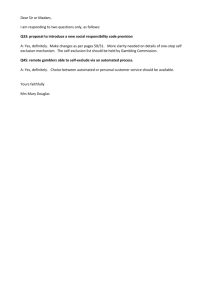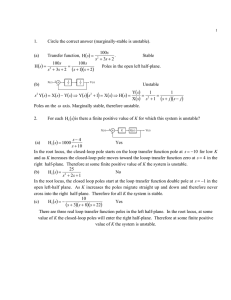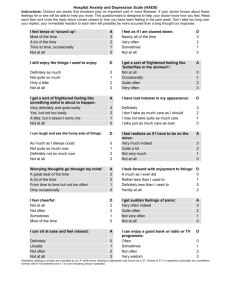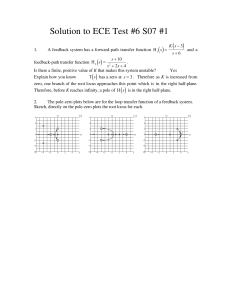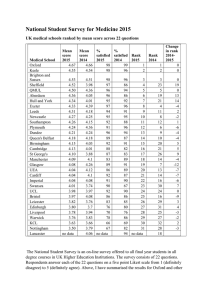Solution to ECE Test #3 Su05
advertisement
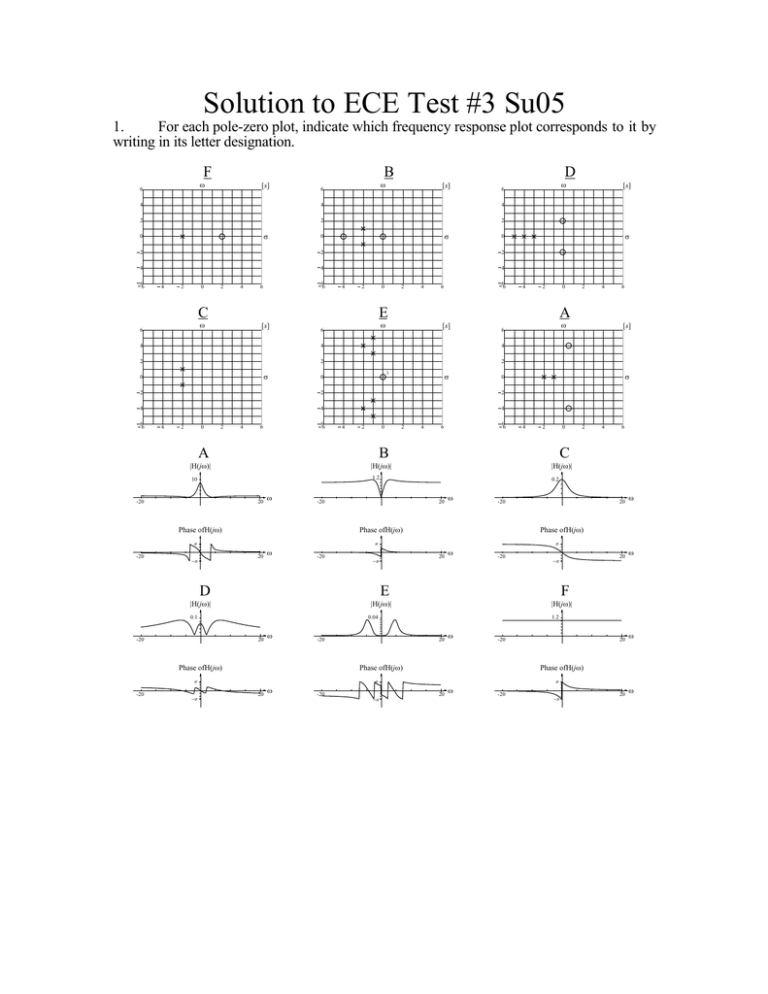
Solution to ECE Test #3 Su05 1. For each pole-zero plot, indicate which frequency response plot corresponds to it by writing in its letter designation. F B ω 6 [s] 4 4 2 2 σ 0 D ω 6 [s] 2 σ 0 2 4 4 4 6 6 6 6 0 2 4 6 4 2 0 C 4 6 6 6 [s] 4 2 2 σ 0 [s] σ 4 4 6 6 6 6 6 4 2 0 A 4 6 6 6 4 2 0 10 1.2 0.2 ω -20 20 -20 ω -20 −π D E |H(jω)| -20 ω -20 ω -20 Phase ofH(jω) ω -20 20 −π −π 20 ω 20 ω 20 ω 1.2 ω -20 Phase ofH(jω) π 20 ω F Phase ofH(jω) π 20 |H(jω)| 0.04 20 6 π 20 |H(jω)| 0.1 4 Phase ofH(jω) π −π −π ω Phase ofH(jω) 20 2 C |H(jω)| π -20 2 B 20 [s] σ |H(jω)| Phase ofH(jω) -20 ω |H(jω)| -20 6 0 4 4 4 2 3 0 2 2 2 4 2 0 0 6 2 2 2 A ω 6 4 4 4 E ω 6 2 σ 0 2 2 [s] 4 2 4 ω 6 π 20 ω -20 −π 2. Sketch a root locus for each of these pole-zero plots assuming that these are the poles and zeros of the loop transfer function of a closed-loop system with an adjustable gain. A B ω ω 8 8 [s] 6 [s] 6 4 4 2 2 σ 0 -2 -2 -4 -4 -6 -6 -8 σ 0 -8 -8 -6 -4 -2 0 2 4 6 8 -8 -6 -4 -2 C 0 2 4 6 8 D ω ω 8 8 [s] 6 [s] 6 4 4 2 2 σ 0 -2 -2 -4 -4 -6 -6 -8 σ 0 -8 -8 -6 -4 -2 0 2 4 6 8 -8 -6 -4 (continued on next page) -2 0 2 4 6 8 For each system indicate whether it will definitely be unstable at some finite positive value of K ( 0 < K < ∞ ) or definitely will be stable for all finite positive K or it is impossible to be sure. Explain your answer. A Definitely unstable at some K, 0 < K < ∞ X Definitely stable for all K, 0 < K < ∞ Impossible to be sure Explanation Two branches of the root locus move into the right half-plane at a finite positive value of K. B Definitely unstable at some K, 0 < K < ∞ Definitely stable for all K, 0 < K < ∞ X Impossible to be sure Explanation For any K > 0, the root locus is in the left half-plane and stays there because the two branches that go to infinity go vertically up and down. C Definitely unstable at some K, 0 < K < ∞ Definitely stable for all K, 0 < K < ∞ X Impossible to be sure Explanation All root locus branches terminate on finite zeros, two of which are in the left half-plane and one of which is at the origin. Therefore for any K less than infinity, the root locus stays in the left half-plane. D Definitely unstable at some K, 0 < K < ∞ X Definitely stable for all K, 0 < K < ∞ Impossible to be sure Explanation One pole is in the RHP and the locus starts there so the system is unstable at low positive values of K. 3. Sketch a canonical realization of a system with the transfer function H (s) = 3 H (s) = s ( s − 2) . ( s + 6) s2 + 4 s + 4 ( ) 3s 2 − 6 s s 3 + 10 s 2 + 28 s + 24 3 6 X(s) 1 s 1 s 1 s 10 28 24 Y(s) 4. Sketch a cascade realization of a system with the transfer function H (s) = 3 H (s) = 3 X(s) s+5 . s + 8s + 7 2 s+5 s+5 1 = 3× × s + 7 s +1 ( s + 7 ) ( s + 1) 1 s 7 5 1 s 3 Y(s) 5. A feedback system of the convential type has a forward-path transfer function K H1 ( s ) = s+8 and a feedback-path transfer function 1 H2 ( s) = . s + 12 K can be any real number. (Not just positive numbers.) For what range of K’s is this system stable? K K ( s + 12 ) K ( s + 12 ) s+8 H (s) = = 2 = 2 K 1 s + 20 s + 96 + K s + 20 s + 96 + K 1+ s + 8 s + 12 The roots of the denominator are at p1, 2 = −20 ± 400 − 384 − 4 K = −10 ± 4 − K 2 For any K greater than 4 the system is stable because the real part of the poles is fixed at -10 while the imaginary part varies. For any K less than 4 the roots are both real. When 4 − K equals or exceeds 10, one root has a non-negative real part. This occurs when K ≤ −96 . Therefore for any K ≤ −96 the system is unstable. So the range of K’s for stability is K > −96 .
